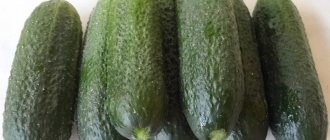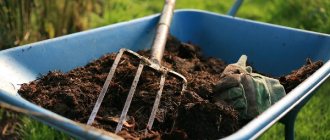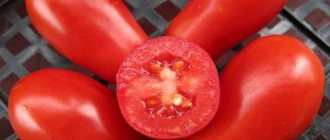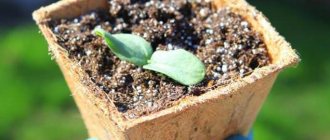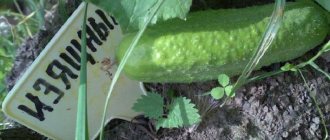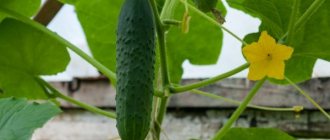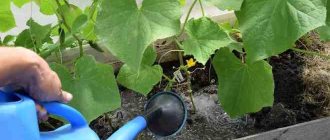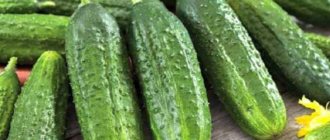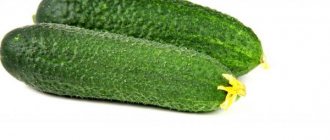The name of the pickled cucumber speaks for itself. This is a tasty variety that is ideal for preparations. But it is also good fresh, so you can safely grow it in your garden for any culinary purposes.
| Landing location | Ripening time | Mode of application | Fruit length | Group | Fruit smoothness | Pollination method |
| Open ground | Mid-early (46-55 days) | Universal | Medium - from 10 to 15 cm | Variety | Highly lumpy | Bee pollinated |
Characteristics of the variety Zasolochny
Pickling cucumbers f1 are a bee-pollinated plant with mixed flowering. That is, on the shoots of bushes, both male and female inflorescences are formed in equal quantities. The Zasolochny variety is grown, as a rule, in the central regions of the Russian Federation, as well as in Nizhnevolzhsk. The variety is also in demand in the southern regions of the country. In addition, they prefer to grow Zasolochny cucumbers in the CIS countries: in Belarus and Ukraine.
According to the ripening period, cucumbers are classified as mid-ripening varieties, since the fruits appear 40-50 days after the sprouts appear. This process usually occurs at the end of July.
Abundant fruiting of cucumbers of the Zasolochny variety is observed 10 days after the appearance of the first gherkins. In just 1 season, each bush of the variety produces about 6 kg of fruit. The fruits are consumed not only fresh, but also used for preparing salads, for preservation and pickling.
Description of pickling cucumbers
- Cucumber bushes reach 2 m;
- The leaves of the plant are dark green in color and reach large sizes with carved edges and slight pubescence;
- Cucumbers are cylindrical in shape and reach a size of up to 14 cm;
- The skin of the fruit is dark green with black spines;
- The pulp of cucumbers is juicy and not bitter;
- The fruits contain small seeds suitable for subsequent sowing.
Description
“Zasolochny” is a bee-pollinated variety, not a hybrid (although some manufacturers offer seeds of the first generation hybrid “Zasolochny F1” of Ukrainian selection). In varietal cucumbers, the development of ovaries and fruit filling occur as a result of cross-pollination, which is provided by insects, transferring pollen from male flowers (barren flowers) to female flowers (with ovaries).
When varietal (not hybrid) cucumbers are pollinated by insects, full-fledged seeds ripen in the fruits, which can be used for subsequent plantings
The cucumber plants of the described variety are monoecious, they contain flowers of different sexes (the type of flowering is mixed). The leaves are quite large, slightly wrinkled. The plants have no natural growth restriction (indeterminate), while the central stem is medium-sized and moderately branched, and the lateral shoots are long-climbing. Growing is possible both vertically (on a trellis) and horizontally (on a spread).
The “Zasolochny” variety is an early ripening variety, but the ripening period largely depends on external factors.
On average, 43-47 days pass from the appearance of full shoots to the start of fruiting, but under less favorable weather conditions this growing season takes up to 55-60 days.
Zelentsy variety in shape, size and quality are ideal for home canning, primarily for pickling
Zelentsy are short (about 11-11.5 cm long with a diameter of up to 4 cm), weighing on average 100-125 g, and have an elongated cylindrical shape. The peel is quite dense, rich green in color with light stripes up to the middle of the length of the fruit and large blurry spots, covered with sparse large tubercles and black pubescence. The taste is assessed as excellent, there is no bitterness at the genetic level, the flesh is dense, juicy and aromatic. Zelentsy have excellent pickling qualities.
The main period of fruiting occurs in the second (summer-autumn) rotation and lasts until the first frost. Commercial yield in open ground is stable and amounts to:
- in the Central Black Earth region - 1.2-2.3 kg/m2;
- in the Lower Volga region – 2.4-2.9 kg/m2;
- with proper care, according to reviews from vegetable growers, it can reach 4-5 kg/m2.
The great advantage of the variety is considered to be the high (94-96%) yield of products with a uniform presentation
Many gardeners note the unpretentiousness of plants, their relative shade tolerance, resistance to most common diseases, including tolerance to downy mildew (peronospora). Disadvantages include the short shelf life of fruits, which negatively affects the possibilities of transportation and storage.
The photo shows packages of cucumber seeds of the “Zasolochny” variety from various manufacturers.
“Zasolochny” seeds are produced by many seed companies in Russia and Ukraine. Often they are pre-disinfected and covered with protective and nutritional shells of macro- and microelements, indicating “coated” or “encrusted” on the packaging.
Manufacturers of inlaid seeds claim an increase in germination by 7-10% and yield by 15-20%.
Coated seeds do not require soaking or dressing before sowing for seedlings or open ground, but have a shorter shelf life. You can familiarize yourself with the procedure for checking the quality of seed material of the “Zasolochny” cucumber variety by watching the following video:
Pros and cons of the variety
Like other varieties of this crop, Pickling f1 cucumbers have a list of positive characteristics and are ideal for growing not only in industrial quantities, but also in small areas. Let's look at the description of the benefits.
pros
- High level of productivity;
- Good taste characteristics of cucumbers;
- Excellent presentation;
- Resistance to many common diseases;
- Resistance to transportability;
- Long-term fruiting of cucumbers;
- Versatility in use.
Minuses
Scientists who worked on the creation of the Zasolochny variety claim that cucumbers have no disadvantages. However, experienced gardeners note the low shelf life of the fruits.
Characteristics
Pickling cucumber is an early or mid-early variety. The stated ripening time is 45-50 days from emergence. However, according to reviews from vegetable growers, in unfavorable conditions of rainy or cold summer, fruiting of the Zasolochny cucumber variety occurs one to two weeks later. Cucumbers planted at the end of May will produce the first gherkins in mid-July. Mass fruiting will begin 7-10 days later.
Thanks to its high immunity, pickling cucumber has good yield. During the season, up to 6 kilograms of greens or 20-25 kg/sq.m. are obtained from one bush. m.
The fruits of this variety are intended for pickling at home, including on a production scale.
Attention!
Despite the fact that the Pickling cucumber was selected specifically for making pickled cucumbers, it is excellent for fresh consumption. Nothing prevents you from pickling or canning it. However, when cooked, it may lose its bright crispy properties.
"Pros and cons"
Pickling cucumber has a number of advantages and is perfect for growing cucumbers in personal garden plots, as well as on farms. Among the obvious advantages are:
- high productivity;
- excellent taste;
- attractive appearance;
- high immunity to diseases, especially powdery mildew.
Among the disadvantages of the Zasolochny variety, some vegetable growers pay attention to the insufficient keeping quality of greens, in their opinion.
Landing Features
It is recommended to plant pickling cucumbers f1 in soil where tomatoes, onions or beans were previously grown. It is not recommended to sow the variety after vegetable crops such as pumpkin, zucchini and cabbage, since they are equally susceptible to spider mite infestation.
Landing dates
It is recommended to plant pickling cucumber seeds in mid-May, when the soil reaches 15 degrees Celsius.
Site preparation
Before planting cucumbers, it is necessary to prepare and select the right plot of land. The variety is recommended to be grown in well-lit places with loose and fertile soil containing a large amount of organic matter.
It is necessary to prepare the site in the autumn. To do this, carefully dig up the soil and remove weeds. Fertilizers are added to the soil: manure and wood ash.
In spring, the soil is loosened and saturated with superphosphate or potassium-phosphorus minerals. They also begin to form the beds.
Planting seeds
Before planting, pickling cucumber seeds must be carefully examined. If the seed is covered with a multi-colored veil of microelements, they are sown dry. If the seeds do not have such a film, they are soaked in a manganese solution for 30 minutes.
After treatment, the seeds are planted in the ground up to 3 cm deep and watered with water at room temperature.
Planting seedlings
To obtain seedlings, cucumbers of the Zasolochny variety are placed in a peat vessel up to 5 cm deep. Afterwards, the seeds are watered with warm water. The container with seedlings must be placed in a sunny place, the temperature of which reaches 25 degrees Celsius.
A week before the seedlings are planted in open ground, they must be hardened off. To do this, peat pots with seedlings of Pickling f1 cucumbers are taken out onto the balcony or outside. It is important to consider that the temperature difference between day and night should vary around 8 degrees.
It is necessary to replant seedlings of Zasolochny cucumbers, as well as the Prolix variety, at the moment when the plant stems reach 25 cm and 5-7 leaves are formed on them. Cucumber seedlings are planted in the middle or at the end of May.
Planting scheme
It is recommended to plant the seeds of Pickling f1 cucumbers according to the 70x40 pattern. To plant seedlings in the ground, holes up to 40 cm deep are dug in advance. Manure and a little wood ash are poured into the bottom of the hole. The sprout is carefully removed from the pot and placed in the hole. The hole is covered with earth and watered with water at room temperature.
Growing and care
Selecting a location
The bushes need sunny areas where there is no strong wind or drafts. It is advisable that they be located on a hill.
The optimal areas are areas where tomatoes, potatoes, peppers or cabbage previously grew. Beds after cucumbers, pumpkins, zucchini, melons or watermelons are not recommended.
Watering
It is best to water in the evenings with warm, settled water. Frequency – 2-3 times a week, but if it’s hot outside, you can water it daily if necessary. At the beginning of development, plants require less water than during fruit growth.
Top dressing
Bushes need 2-3 feedings during the growing season. You should not overuse them, so as not to overfeed the bushes. It is better to alternately apply organic matter and mineral fertilizers.
Many gardeners avoid superphosphate, nitrate and potassium sulfate, introducing new portions of manure instead. This is mistake. Plants require potassium and phosphorus, which they can obtain in sufficient quantities only from mineral fertilizers.
The recommended composition is 10 g of superphosphate and 4 g of potassium chloride and ammonium nitrate per bucket of water. This remedy is applied at the root during bush growth. When the ovaries appear, the dosage is doubled and fed again.
Garter
Bushes can be tied to horizontal or vertical trellises. High supports are installed along the bed, and a thin cotton rope is stretched between them. This is the simplest support to which the whips are attached.
Stepsoning
If the bush is tied to a vertical support, it is pinched, cutting off all the lateral shoots except the central lash. The central lash is pinched when it exceeds the length of the support. In open ground it can be grown in a spread pattern without planting. Then the main vine is pinched only if it begins to interfere with other plants.
Care
After planting cucumbers, the plants need proper care: systematic watering, tying and forming bushes, as well as fertilizing and hilling. Let's look at the description of care activities.
Watering
It is necessary to water the pickling f1 cucumber variety with water at room temperature in the early morning or late evening. The main thing is to refrain from watering the plant in the very heat.
When watering, it is necessary to avoid getting water on the cucumber leaves, that is, the liquid should get directly under the root.
Garter and bush formation
It is necessary to tie and shape cucumber bushes by pinching the side shoots at a distance from the stem to 4 internodes.
It is recommended to tie the bushes with a tight rope up to 2 m high. To do this, lightly tie the stem of the sprout and let the rope go up. Next, the stem will independently curl around its rope.
Top dressing
It is necessary to fertilize Pickling cucumbers with organic and mineral substances. During flowering, it is recommended to feed the plant with ovary formation stimulants. It is necessary to feed the bushes once every 10 days.
Hilling
Since cucumbers are a crop whose root system is located close to the surface layer of the earth and spreads along it, they do not need hilling. Thus, the roots of cucumbers can be damaged, as a result of which the plant will wither and die.
However, experienced vegetable growers recommend loosening the soil with a pitchfork. Loosening allows oxygen to reach the roots of the plant and also helps remove weeds. It is necessary to loosen the soil once every 7 days.
Other best pickling varieties of cucumbers
Classic varieties for pickling and canning are:
- "Nezhinsky". Experienced gardeners believe that this is the best variety. It is disease resistant and does not require attention; it is pollinated by insects.
- “Competitor” refers to early varieties, the fruits grow up to 12 cm.
- "Erofey". This is a universal variety with a mixed type of flowering, small fruits (6-7 cm), tuberculate.
Nezhinsky
The following varieties are also suitable: “Era”, “Stadiya”, “Nosovsky”, “Muromsky”, “Cascade”, “Spring”, “Bolshoy”.
In appearance, cucumbers of any of these varieties have all the qualities of “pickling”: medium size, thin skin and fairly dense pulp. In pickled and salted form, these cucumbers are strong and crunchy. An additional advantage is the ability to obtain high-quality seeds.
Expert opinion
Filatov Ivan Yurievich, private farmer for more than 30 years
Cucumbers for open ground are self-pollinating for pickling: Zozulya, Zador, Alliance. Fans of very small canned cucumbers can grow "Parisian Gherkin" or "Liliput". They are very fruitful and have excellent taste.
For those whose territory is little illuminated by the sun, the best varieties of cucumbers for pickling may be:
- “Muromsky 36” are small light green cucumbers (length 6-8 cm), resistant to short-term drops in air temperature.
- “The secret is universal varieties with medium-sized fruits.
Diseases and parasites
The Zasolochny cucumber variety is resistant to most cucumber diseases. Cucumbers are not susceptible to even the most common disease - powdery mildew. However, do not forget about preventive measures.
As a preventive action, spray the bushes with a mixture of sour milk and water in a ratio of 1 to 1. A solution of 5% soda with soap is also used.
Despite their resistance to diseases, Zasolochny cucumbers can become infected with bacteriosis, root rot, and also succumb to spider mite invasion. Let's look at the description of each disease.
Bacteriosis
Bacteriosis, or angular leaf spot, is a fungal disease that affects pumpkin crops. During bacteriosis, oily brown spots form on cucumber bushes. During drought, these spots become covered with a thin crust and fall off along with a piece of the leaf.
Bacteriosis is formed by transmission through seed material that was collected from an infected plant. For prevention, Filavin-300 and TMTD are used.
Root rot
Root rot is a disease that occurs as a result of frequent watering. As a result of a large amount of liquid, oxygen does not reach the root system, therefore, the roots of the plant weaken.
With root rot, darkening of the roots and stems of the bushes of the variety is observed. In the heat, the leaves of the plant begin to wither, which leads to their death. For prevention, dusting the bushes with chalk, sawdust, sand or peat is used.
Spider mite
The spider mite is a small pest that gets used to a variety of types of poison and continues to reproduce, causing harm to the fruits of the plant. The pest damages the plant cells of the pickling cucumber bushes, leaving behind white spots and cobwebs on the leaves.
To combat ticks, biological products (Fitoverm, Akarin and Vertimek) and acaricidal substances (Floromite, Oberon, Apollo and Nisoran) are used.
Diseases and pests
The Zasolochny variety is resistant to most diseases, including the main enemy of cucumbers – powdery mildew. But preventive measures still won’t hurt. Spraying with a sour milk solution at the rate of: liter of milk per 1 liter of water, or 5% soda solution with the addition of a small amount of laundry soap helps.
If the disease has already manifested itself, the affected plants are removed and the ground is treated with a strong infusion of manganese potassium. The remaining plants are treated with a phytosporin solution. If fruiting of cucumbers has not yet begun, you can treat the plantings with a solution of copper sulfate or any fungicide according to the instructions.
To combat spider mites, use a solution of laundry soap at the rate of one bar per 10 liters of water and mulch the soil with wood ash.
Two weeks before the expected harvest, it is advisable to stop all fertilizing and treating plants with chemicals.
Harvesting and storage
The fruits of the Zasolochny variety are collected once every 2 days. It is recommended to pick cucumbers immediately after they appear so that they do not interfere with the formation of new fruits.
Cucumbers are usually stored in a cool place. For long-term storage, use a room whose temperature will not exceed 5 degrees Celsius. A basement or cellar is suitable for long-term storage of cucumbers. If Pickling cucumbers will be used in the near future, they are stored in the refrigerator.
It is important to know that the color of the spines located on cucumbers indicates their use: cucumbers with black spines are suitable for pickling, and cucumbers with white spines are suitable for fresh consumption.
Reviews from gardeners
Elena Ivanovna, Voronezh region: “Zasolochny” is my favorite variety of cucumbers - undemanding and productive. I grow it through seedlings, planting them in early June. Pickled cucumbers, pickled and salted. The resulting preparations are stored well, the cucumbers do not lose their crispness.
Valentina Sergeevna, Orel: “The pickled cucumber is an excellent choice for growing in garden beds. It produces vigorous shoots, develops well, and is little susceptible to powdery mildew, various rots, and weather changes. The main harvest period falls on July-August, giving the opportunity to make a lot of vegetable preparations. I grow it myself and recommend it to everyone.”
“Pickling” cucumber is specially intended for preservation
Evgeniy Anatolyevich, Kaluga region: “I grow cucumbers for myself and for sale. “Pickling” is a productive and tasty cucumber, due to pollination by bees it is only suitable for open ground, and there is a lot of fuss with them in the greenhouse. Small, dense, homogeneous - one cucumber, used mainly for canning, but can also be eaten fresh. Requires caution when transporting."
Based on reviews of the experience of growing the “Zasolochny” variety, these cucumbers do not create any particular difficulties with cultivation, giving consistently good yields and having versatility of use.
Cucumber “Pickling”: description of the variety, photos and reviews
The “Pickling” cucumber is one of the most popular traditional pickling varieties. Work on its selection was carried out under the leadership of V. A. Shefatov on the basis of the Volgograd Experimental Station VNIIR named after. N. I. Vavilova RAAS (Krasnoslobodsk). The variety was included in the State Register in 2000.
“Zalochny” is recommended for cultivation in open ground in the Central Black Earth and Lower Volga regions, as it is well adapted to local soil and climatic conditions. The variety has become widespread in Ukraine.

